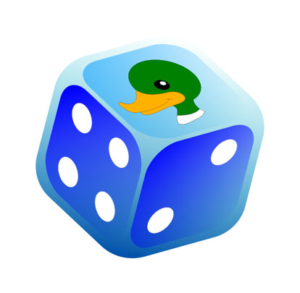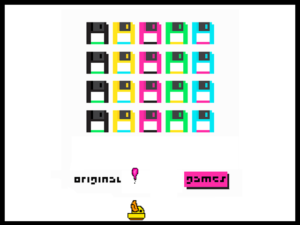Game Synopsis
The Original games Advert Game is an ad remake of the iconic game Space Invaders.
Research and Development
I began development on this game after stumbling across a genre of games that has been around for a long time but recently became somewhat of a phenomenon in the games industry. The genre of the ad game is pretty much a game that is just an ad, or is it an ad that is interactive? In either case it seemed like an interesting genre to explore and the Original Games logo seemed to be a perfect match for a Space Invaders clone. In the logo, there are floppy disks lined up along the top which could resemble the invading aliens. With the design concept ready I jumped into development.
First off, I have a new-found respect for the game Space Invaders. The coding for this game was much more complex than I had anticipated and with it came plenty of debugging and frustration. Needless to say, development dragged on much longer than I had originally planned, but in the end I am pretty proud of this charming Space Invaders clone. I will now go into some details for some of the interesting development concepts and about this dark ad game genre.
An intriguing Unity development I was introduced to in this project is the new Input system. The new Input system is a stand alone package while the legacy Input Manager is run through the project settings window and is there by default. I was hesitant to experiment with the new system but after some trial and error, I could see where the benefits of this new system are. Rather than having the scene run by a single Input map, you have an Input Actions object within your scene that holds the mappings. This allows for multiple mappings that have the potential for some interesting gameplay. For instance, your character goes from walking to driving a car in your game. You can easily change the Input mapping through the Input Action object.
Another concept that was completely new to me was the Matix. Not the 1999 Keanu Reeves sci-fi classic; the enemy matrix I built to move the characters in unison. This concept pushed the ideas of nested “for-loops” I discussed in the write up for Pandemic Duck even further. The matrix of enemies acts as a container for the array of game objects. Once set with the proper parameters I was able to move the enemies in a line-by-line way that resembled the movement of the classic arcade game Space Invaders. This was done by a nested for-loop, one for the x-axis and one for the y-axis. It was complicated to create the movement across the screen but what was even more challenging was creating the system to detect the change in direction. This was done though another script that detects the collision of the game’s boundaries that moves the enemy down and changes its direction. What made this even more complicated was that the game object had to detect this movement and had to pass its detector script to the neighbouring enemy on death. Building this system gave me new insights of the complexity of this seemingly simple classic arcade game. Even though working on this game was quite rigorous, I learned some new concepts through the development.
The main purpose for this Space Invaders clone game is to be an ad for Original Games. This ad style game has become a very mainstream way of marketing. Interactive Facebook ads caught my attention and led me to the development of my Advert Game. Having my main marketing platform based around Facebook and Instagram this seemed like a logical choice. For these interactive ads on Facebook all you needed was a lead in video and an HTML5 playable game. Knowing this I stayed with the web WebGL platform and aim to release my first Advert Game for Original Games on Facebook early January 2021.
People are naturally drawn to anything that they can connect and interact with.
“While different forms of advertising, such as TV ads or banners, can be easily skipped or quickly forgotten, advergames can create hours of engagement” [1]
A playable ad allows the consumer to be a part of the advertisement. On top of that, the ad is a spin-off of a classic game that can be enjoyed by all ages. The Advert Game is a concrete example of Demonstrative Advertising, Ian Bogost describes this well in his writing on the The Three Types of Advertising, he states:
“Demonstrative advertising provides direct information. These ads communicate tangibles about the nature of a product.” -Bogost 153 [2]
He also writes “demonstrative games dovetail most closely with the procedural properties if the video game medium” -Bogost 158 [3]
Having an effect and well thought out advertisement campaign will ensure that Original Games progress in popularity in the indie game market.
As I dove deeper into the genre of Advertisement Games I realized that there are companies whose sole purpose is to reskin games for marketing purposes. One of these companies that stood out to me was Gamify. According to their article “13 Reasons to Use Games in Your Marketing Strategy”, the term “Gamification Marketing” was coined in 2010 making this mode of advertising relatively new to the world of marketing. The article also lists fifteen very persuasive points that game ads have that other ads may not. For instance the being fun and engaging or die to their unique nature avoid many ad blocker software on the market.
I found some other interesting statistics when researching the effectiveness of this type of ad. According to the “Facebook success story on Kakao Games” [5] they had an 80% lower cost per click with playable ads (compared to other ads in the same campaign). With these statistics and selling points, I’m confident that my Advert Game for Original Games will have a positive effect on its popularity in the marketplace.
While gaining popularity through social and philosophical is one of the main driving forces of Original Games, Monetization is also a large consideration. In the book ONE UP by Joost Van Dreunen he states
“I’ve repeatedly observed the tendency among aspiring creatives to sacrifice any financial expectations to see their creative vision to become reality” Van Dreunen – XII [6]
I plan to publish the games with a monetization strategy in place. An insightful and enjoyable book I have read lately is Scott Rogers’ Level up: The Guide to Great Video Game Design. With a heavy on game design he does touch on monetization Rogers states:
“People can lose their head when it comes to money, so it’s always best to treat others the way you’d want to be treated. If you think your monetization method is taking advantage of your players, perhaps it’s time to rethink that plan. Your players will appreciate it in the long run” -Rogers pg425 [7]
This quote resonates as a cornerstone for any monetization strategies I put in place. By keeping these ethics in mind I hope to sustain the popularity of my games.
Playtest Reviews
“Growing up, Space Invaders was one of my favourite games! I was so stoked that Original Games made an advergame that is a clone of my favourite game with a ducky twist! Of course I played it lots ;)”
“This playable ad definitely worked! I want to play all the Original Games games :O”
“If this game becomes a full on app game, it would be real neat to pick up some power-ups or coins from the disks that get destroyed maybe? It would sure be neat in later levels or whatnot for sure! Everyone loves loot!”
“I love how the defending character is a rubber ducky.”
Citations:
[1] The role of flow for mobile advergaming effectiveness | Emerald Insight. (2019, November 11). Https://Www.Emerald.Com. https://www.emerald.com/insight/content/doi/10.1108/OIR-06-2018-0198/full/html
[2, 3] Bogost, I. (2010). Persuasive Games: The Expressive Power of Videogames (The MIT Press). The MIT Press.
[4] Denton, M. (n.d.). 13 Reasons Why You Should Use A Video Game Marketing Strategy. Retrieved November 05, 2020, from https://www.gamify.com/gamification-blog/15-reasons-to-use-games-in-your-marketing-strategy
[5] Kakao Games & Wisebirds, Increasing downloads with Facebook’s playable ads. (n.d.). Facebook. https://www.facebook.com/business/success/kakao-games-wisebirds
[6] Dreunen, V. J. (2020). One Up: Creativity, Competition, and the Global Business of Video Games. Columbia Business School Publishing.
[7] Rogers, S. (2014). Level Up! The Guide to Great Video Game Design (2nd ed.). Wiley.





